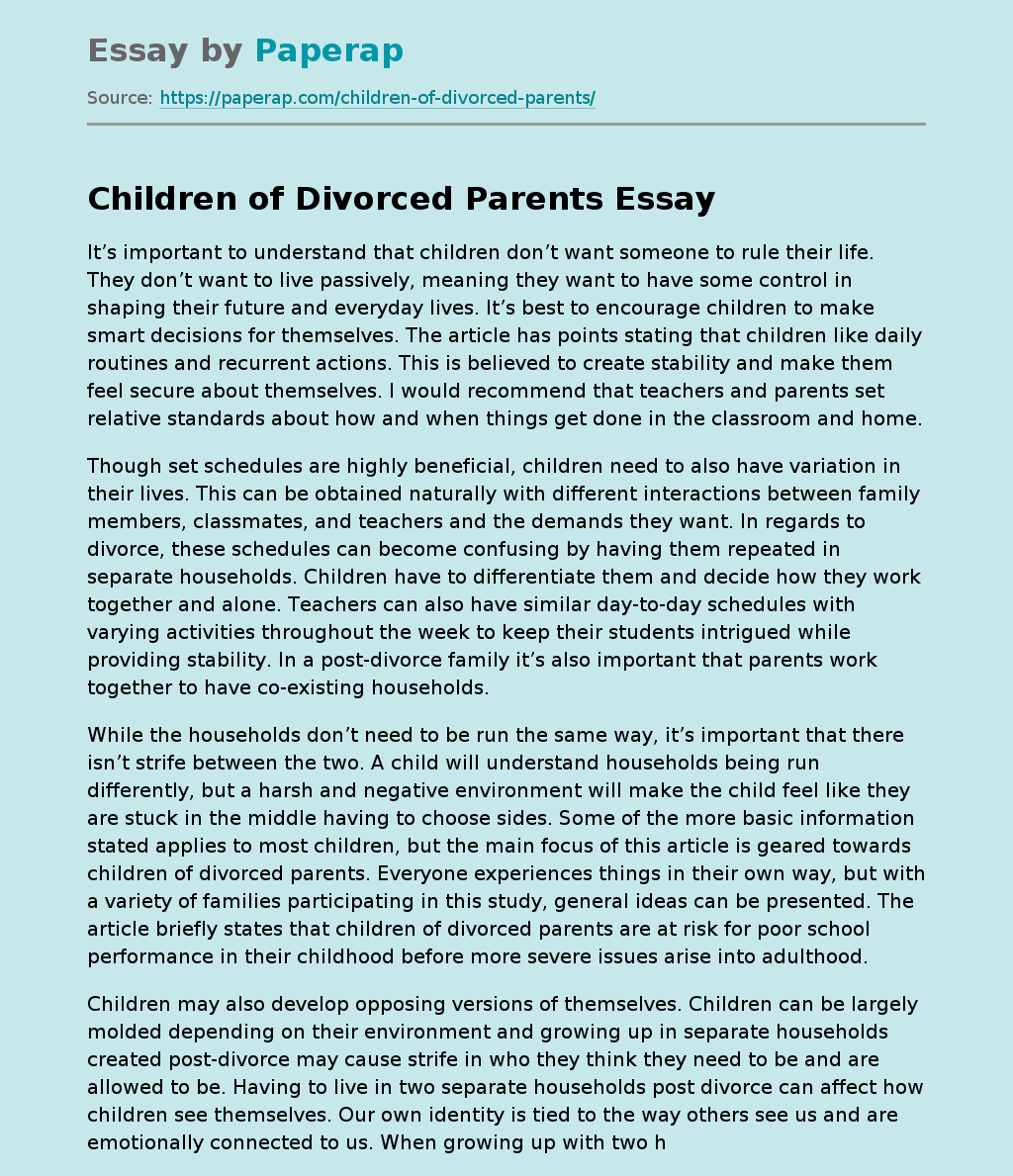Children of Divorced Parents
It’s important to understand that children don’t want someone to rule their life. They don’t want to live passively, meaning they want to have some control in shaping their future and everyday lives. It’s best to encourage children to make smart decisions for themselves. The article has points stating that children like daily routines and recurrent actions. This is believed to create stability and make them feel secure about themselves. I would recommend that teachers and parents set relative standards about how and when things get done in the classroom and home.
Though set schedules are highly beneficial, children need to also have variation in their lives. This can be obtained naturally with different interactions between family members, classmates, and teachers and the demands they want. In regards to divorce, these schedules can become confusing by having them repeated in separate households. Children have to differentiate them and decide how they work together and alone. Teachers can also have similar day-to-day schedules with varying activities throughout the week to keep their students intrigued while providing stability.
In a post-divorce family it’s also important that parents work together to have co-existing households.
While the households don’t need to be run the same way, it’s important that there isn’t strife between the two. A child will understand households being run differently, but a harsh and negative environment will make the child feel like they are stuck in the middle having to choose sides. Some of the more basic information stated applies to most children, but the main focus of this article is geared towards children of divorced parents.
Everyone experiences things in their own way, but with a variety of families participating in this study, general ideas can be presented. The article briefly states that children of divorced parents are at risk for poor school performance in their childhood before more severe issues arise into adulthood.
Children may also develop opposing versions of themselves. Children can be largely molded depending on their environment and growing up in separate households created post-divorce may cause strife in who they think they need to be and are allowed to be. Having to live in two separate households post divorce can affect how children see themselves. Our own identity is tied to the way others see us and are emotionally connected to us. When growing up with two households and two families who may have different expectations and desires for their child, children may have a conflicting self-identity. Alternatively, having two varying identities can allow children to pick and choose good attributes from each side. After divorce, many focus on the negative drama and possible damaging results.
Few think about the child and the effort they showcase of how they are going to make it work. Having two households can give children an opportunity to establish themselves and decide how they need to be cared for. They can look at the two households and see what works best in regards to their care and make it known for both parents. Other children growing up in one household don’t have this opportunity and just have to take what is presented because it is all they’ve ever known. The participants were made up of eight post-divorce Danish families who were found via divorce websites talking about split living arrangements or through word of mouth. There were seven mothers, seven fathers, two step-parents, and ten children involved. The children, three girls and seven boys, were all ranged from 8-12 years of age. The parents had also divorced at different age points for the children, some young enough to not remember their household pre-divorce. The families lived in a variety of environments including the city, suburbs, and country. The participating families were also of middle class socioeconomic status.
As the article points out, children who split their time between two families post divorce is most commonly done in middle class families. Data was collected via 1-2.5 hour interviews with both the parents and the children in locations were they felt comfortable, like the home or at school. Parents and children were interviewed both separately and together. The children were also given mp3 recorders to provide daily insights while transitioning between households. This articles focuses on how children adapt to having two seperate families post parental divorce. It describes how they work to combine the differing household experiences and values. The article also states that the children and their parents are not solely responsible for shaping their everyday lives. The children are more obviously affected by their parents choices. But parents can be just as influenced by their children if they are giving them the opportunity by asking insightful questions to shape their everyday lives.
Children of Divorced Parents. (2021, Dec 14). Retrieved from https://paperap.com/children-of-divorced-parents/

